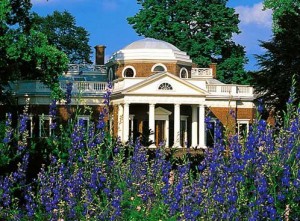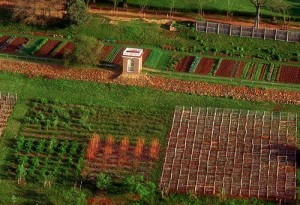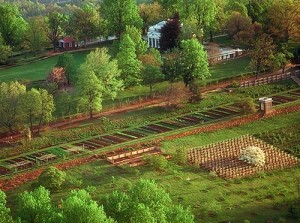
Thomas Jefferson, the third president of the United States, was the author of the Declaration of Independence and founded the University of Virginia. But he also was a highly knowledgeable gardener and farmer. At Monticello, he grew 330 varieties of vegetables, 170 fruit varieties and amazing flower gardens, such as these larkspurs (Consolida orientalis) growing in the west front of the property. Not surprisingly, this wise gardener practiced crop rotation in his garden too.
Photo copyright © Thomas Jefferson Foundation, Inc.
Crop rotation is an old method of rotating the edible crops grown in a certain place, so the garden soil stays fertile and healthy. Basically, you want to avoid planting edibles from the same plant family in the same place in your garden, more than once every three years – sometimes longer.
Aerial photo of mulberry row, vegetable garden and south orchard.
Copyright Thomas Jefferson Foundation/Leonard Phillips.
To practice crop rotation, you’ll need to know the plant families of your edibles. Check here for that information. You’ll also need to keep good gardening records, so you’ll remember what you’ve grown over the years. That way you can avoid growing your favorite edibles and their siblings in the same spots in your garden.
Thomas Jefferson not only practiced crop rotation, but he also grew cover crops like clover and peas that added nitrogen and healthy organic matter to the soil. These living mulches suppressed weeds, and attracted beneficial insects as well.
As he explained in a letter dated 1798, “My rotation is triennial… one year of wheat and two of clover in the stronger fields, or two of peas in the weaker, with a crop of Indian corn and potatoes between every other rotation, that is to say once in seven years.”
Using this method, wrote Jefferson, “aided with some manure, I hope my fields will recover their fertility, which had … been completely exhausted by perpetual crops of Indian corn and wheat alternately.”
Monticello Mountain from south, main house,
vegetable garden, south orchard.
Copyright Thomas Jefferson Foundation.
Here’s a Seasonal Wisdom interview with Peter Hatch, the renowned historian who supervised the restoration of the Monticello gardens.
Learn more about cover crops, crop rotation … and Monticello.
Have you seen George Washington’s Mount Vernon yet? How about this asparagus recipe from 1763?
Source of Thomas Jefferson quote – “Nature’s Bank – The Soil,” (National Wildlife Federation; 1953).













Comments on this entry are closed.
{ 2 trackbacks }